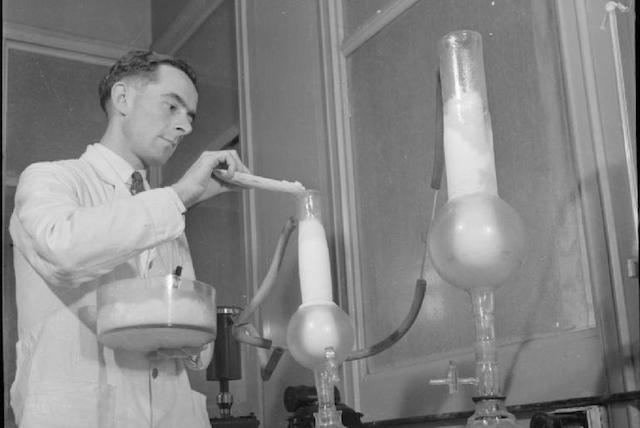We tend to think that powerful, world-changing innovations require complex engineering and great scientific effort, but this is not always the case. Sometimes simple improvements, like ball bearings and barbed wire, have had a huge impact on the course of human history, often leading directly to the more complex engineering we see today.
10. Barbed wire

The history of modern barbed wire goes back to an American businessman and inventor To Joseph Glidden . His two-strand design, patented in 1874, revolutionized the way fences and other barriers were built around the world, especially in America, allowing more land to be fenced than ever before. Before his invention, farmers and ranchers had to use wooden fences or stone walls to enclose their land, which was either ineffective or time-consuming and expensive.
Barbed wire had a profound effect on the colonization of America, especially in the “taming of the Wild West.” It made it possible to divide vast amounts of land into smaller, more manageable units, allowing settlers to better protect their crops and livestock. It helped speed up the expansion of the western frontier by making it easier for settlers to establish homesteads and ranches in remote areas, leading to economic and territorial expansion. It was now much easier to define and enforce property and fencing laws, as the state was largely unable to do so in more remote border areas.
9. Flashes

While flares have been used for navigation and other purposes for a long time, the modern flare was first made by a businesswoman and inventor named Martha Coston. Patented in 1859, the prototype was based on a design left by her late husband Coston flashes were made from colored paper tubes filled with chemicals that produced a bright , colorful flashes, significantly improving on their predecessors in both durability and brightness.
This invention later played a significant role in the American Civil War, as it was very useful for communication between ships, signaling enemy positions, and for better coordinating battle strategies over long distances, especially during night battles. Even during world wars flare guns proved to be an important tool for all sides, providing a simple yet effective way to send messages to allied units. Today, flares are still critical for emergency services and search and rescue services.
8. Ball bearing

Ball bearings are a type of bearing that use small spherical balls to reduce friction between rotating parts. The concept dates back at least to Ancient Egypt , although only with the invention of the Bessemer process and the bicycle in the mid-19th century, they could be mass-produced and used in a variety of applications. While the Bessemer process made it possible to produce high-quality steel more cheaply and efficiently, the bicycle was the first mass application of this technology in the real world.
The invention allowed engineers to significantly reduce friction and wear on rotating parts, which greatly increased the reliability and durability of industrial-era machines. Ball bearings also allowed for smaller, more compact machines because they took up less space and weighed less than traditional bearings. Today, it is impossible to make an impeller that stays on its axis without near-perfect spherical bearings, as they are used in a wide variety of devices, from simple household appliances to heavy military equipment.
7. Penicillin

September 28, 1928 Scottish A microbiologist named Alexander Fleming made one of the most important discoveries in the history of medicine. While experimenting with the flu virus, he noticed that one of his petri dishes had become contaminated with a kind of mold that was preventing the growth of the bacteria he was studying. Even if completely unintentionally, Fleming had stumbled upon a fungus called Penicillium.
From this he synthesized the antibiotic we now know as penicillin, which has since had a huge impact on modern life, especially during wars From World War II to the recent war in Iraq, penicillin has saved countless lives by healing injuries that would otherwise be fatal. Before penicillin, bacterial infections like pneumonia were often fatal and difficult to treat. Now it is the most widely used antibiotic in the world, reducing mortality rates and improving the quality of life for millions of people worldwide.
6. Throwing things

Throwing objects like a projectile emerged in human evolution about two million years ago. This ability gave early humans a distinct survival advantage by allowing them to access new, larger food sources. The first projectiles were likely rocks, which were easily accessible and could be picked up and thrown with precision. It was only a matter of time before the javelin was invented and perfected, ushering in a whole new phase of human evolution and development.
The evolution of the javelin directly led to a number of important changes in the human body, particularly in the size and shape of the human shoulder , which became more streamlined and allowed for greater speed and accuracy of throwing. This had other important social and cultural consequences, as early hunting how cooperative activity gave early humans a sense of security and control over the environment, allowing for further expansion and conquest.
5. Transistor
Transistors were created in 1947 by John Bardeen, Walter Brattain, and William Shockley at Bell Telephone Laboratories in Murray Hill, New Jersey. This was the first major step in the miniaturization of electronics, as transistors replaced bulky electronic tubes smaller, more efficient and reliable devices.
It revolutionized the world of electronics, ultimately paving the way for the development of the modern computer and semiconductor industries. Transistors allowed engineers to develop devices that could perform the same functions as much larger machines, allowing for smaller, faster, and much more powerful electronic gadgets. Today, improved and modern forms of transistors, such as Integrated circuits and microprocessors play a key role in most of our everyday devices.
4. Magazine rifle

To Before the invention of repeating rifles, firearms had a limited rate of fire and required reloading after each shot, which significantly limited their overall effectiveness in combat. This changed with the advent of the first prototypes of repeaters, allowing soldiers to fire multiple shots in rapid succession. The first repeating rifles were invented in the mid-19th century, and the famous Henry rifle became the first working model that made a difference on the battlefield.
Repeaters revolutionized early modern warfare, as firearms became the most lethal weapons a single fighter could wield. It was now possible to engage multiple enemies from a much greater distance than ever before, which had a major impact on tactics. And strategy of the time. Increased firepower also meant that battles could be won more quickly, reducing casualties and the length of battles.
3. Lever

At its core, a lever is a simple mechanism with a straight beam or rod that rotates around a fixed point called a pivot. supports . This allows for increased force in many ways, allowing very heavy objects to be lifted with significantly less effort. Although we don't know exactly when it was invented, the lever was first described mathematically by Archimedes. He was apparently so impressed by it that said "Give me a fulcrum and I will move the world with a lever," although that may have been a bit of a stretch.
However, it is difficult to overestimate the importance of the humble lever, especially in the construction of early civilizations such as Egypt and Greece. This allowed us to build larger, more complex structures, such as pyramids and aqueducts, because suddenly it was possible to move heavy stones and other building materials with ease. Today, advanced types of levers are used in almost every aspect of our lives, from simple household tools such as can openers and pliers to complex machines such as cranes and earthmovers.
2. Sailing

We use sails as a means of transportation throughout millennia , even if it is difficult to pinpoint who invented them first. For the first time, sails allowed ships to harness the power of the wind, allowing them to travel much further than was possible with oars alone.
Although not a sophisticated machine, this simple improvement revolutionized maritime navigation, making trade and commerce with distant settlements possible. The use of sails also allowed ships to sail against the wind, opening up entirely new lands for trade or conquest. With the help of navigation, early civilizations were able to explore new lands, establish trade routes and interact with new cultures they had never known, which in turn led to the development of more complex economies and cultures around the world.
1. Paper money

Although paper money had been used in many parts of the world before, it was not until Europe during the Crusades that hikes This system became a reality. European armies and merchants needed a way to transport large amounts of money without being burdened by the weight of metal coins, which led to the first forms of modern paper money, called bills of exchange.
This practice soon spread throughout Europe and across the Atlantic, as the introduction of paper money also played a major role in the colonization of the Americas. At the time, shipping between Europe and North America was time-consuming, leading to a constant shortage of cash for settlers and merchants. Paper money allowed them to access the capital they needed to finance projects without having to transport large quantities of precious metal coins across the Atlantic. It also made it easier for European merchants to trade with the native populations and other European colonies in the Americas, as it was much easier to transport and less likely to be lost or stolen than previous forms. currencies .













Оставить Комментарий